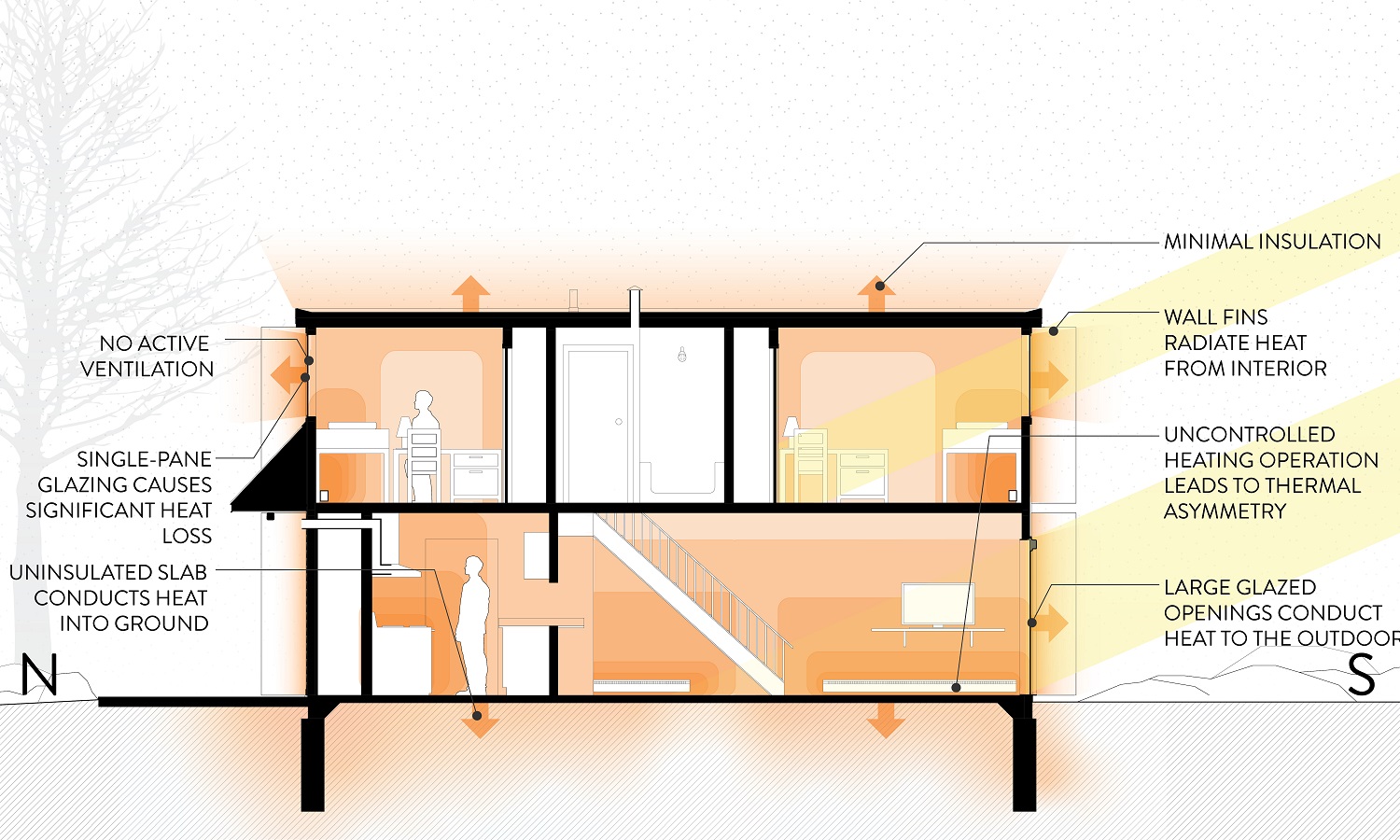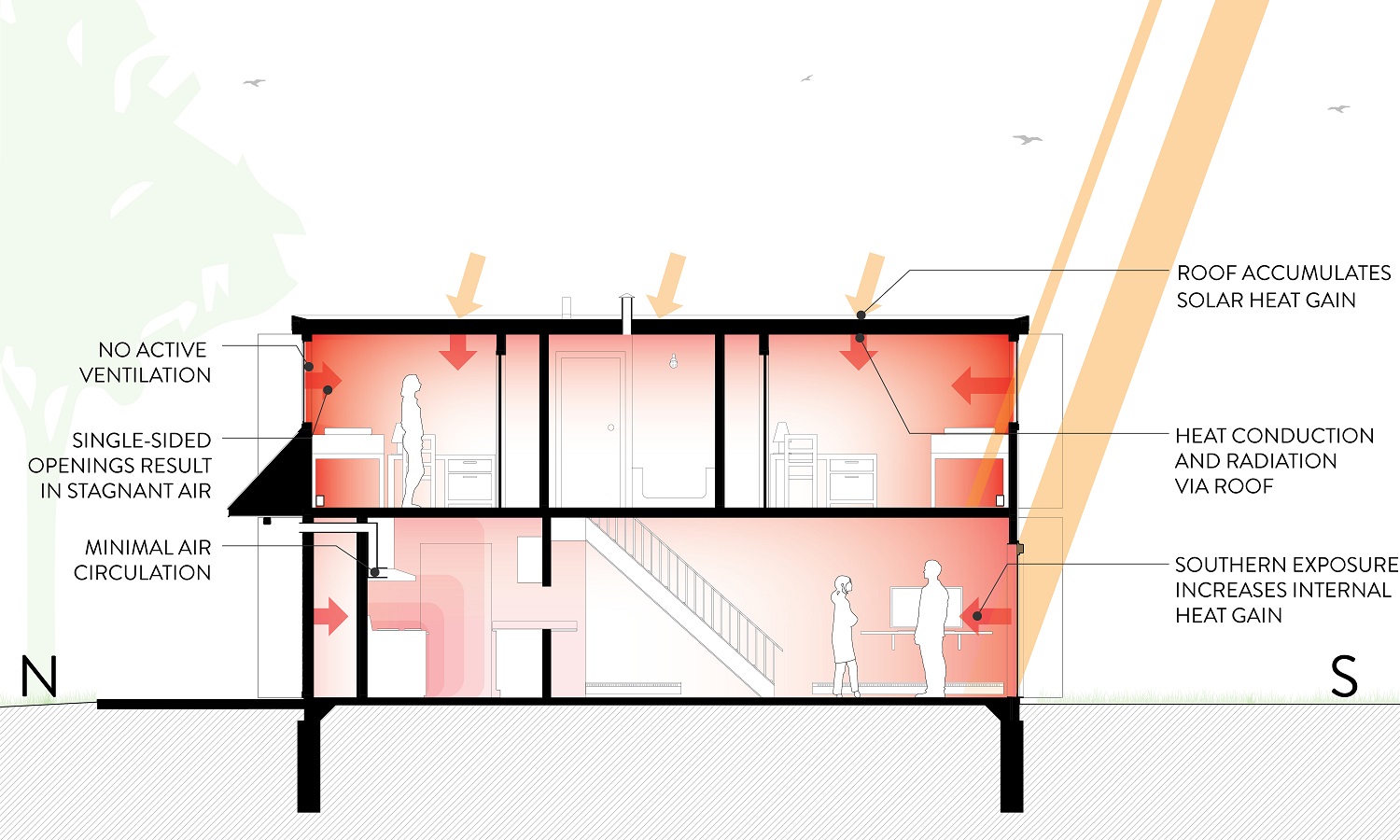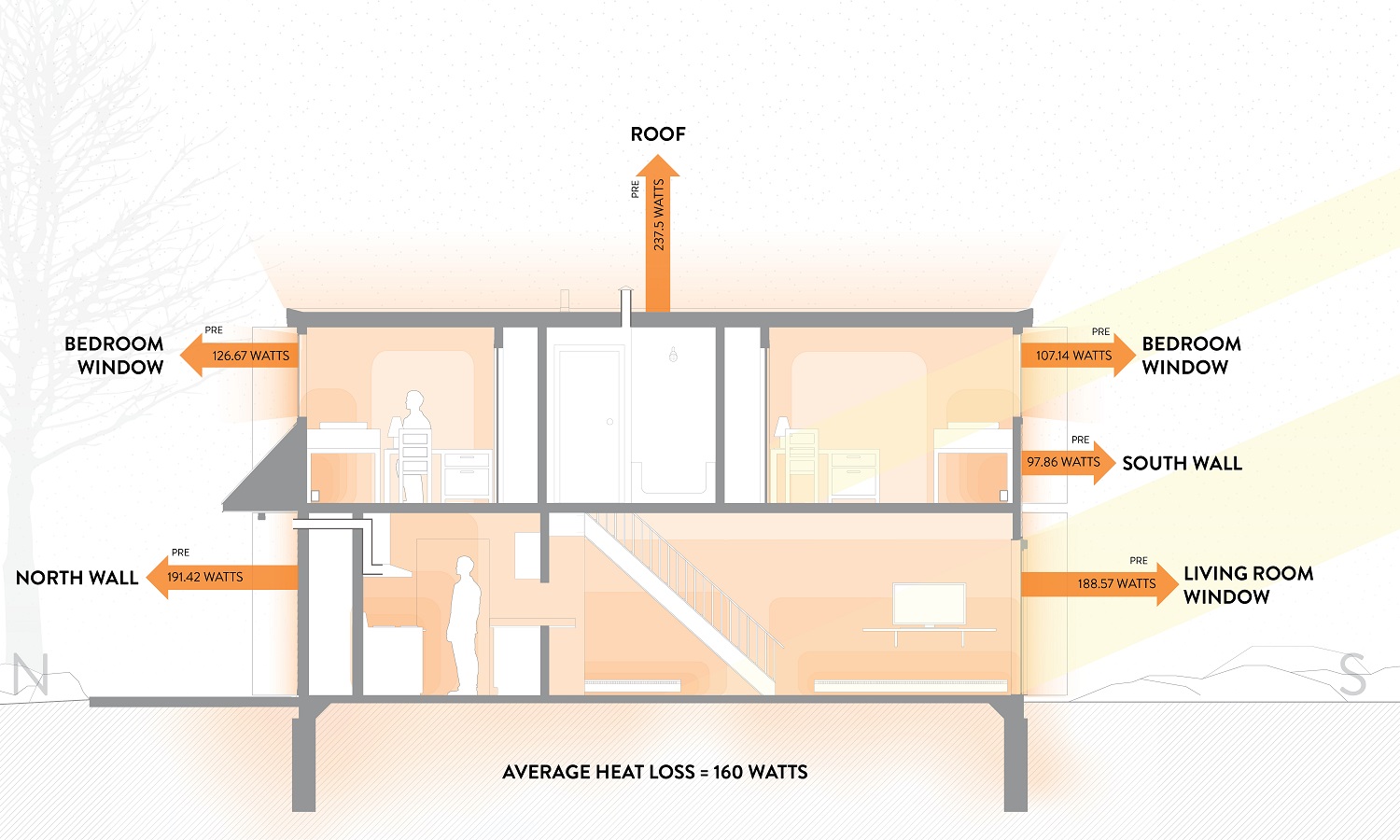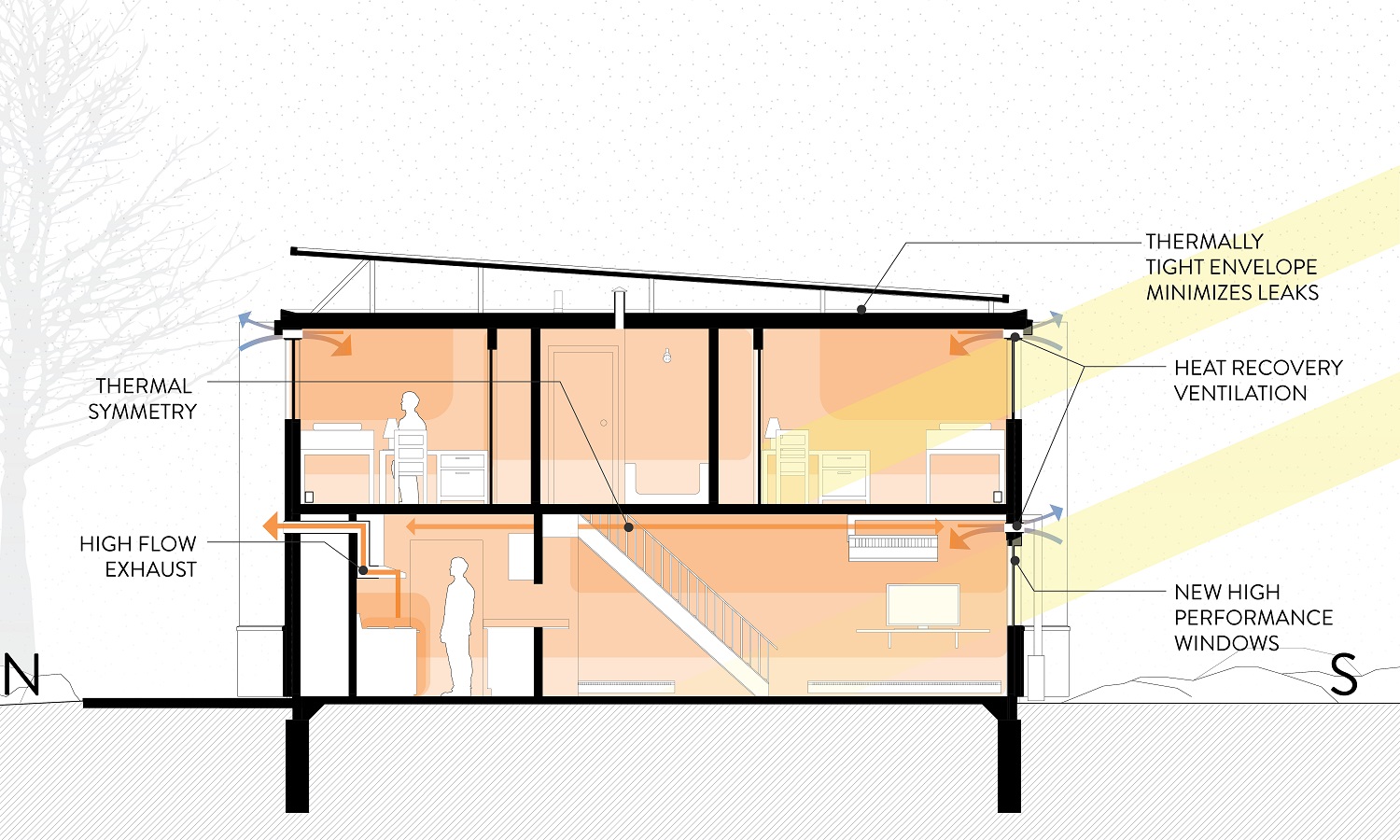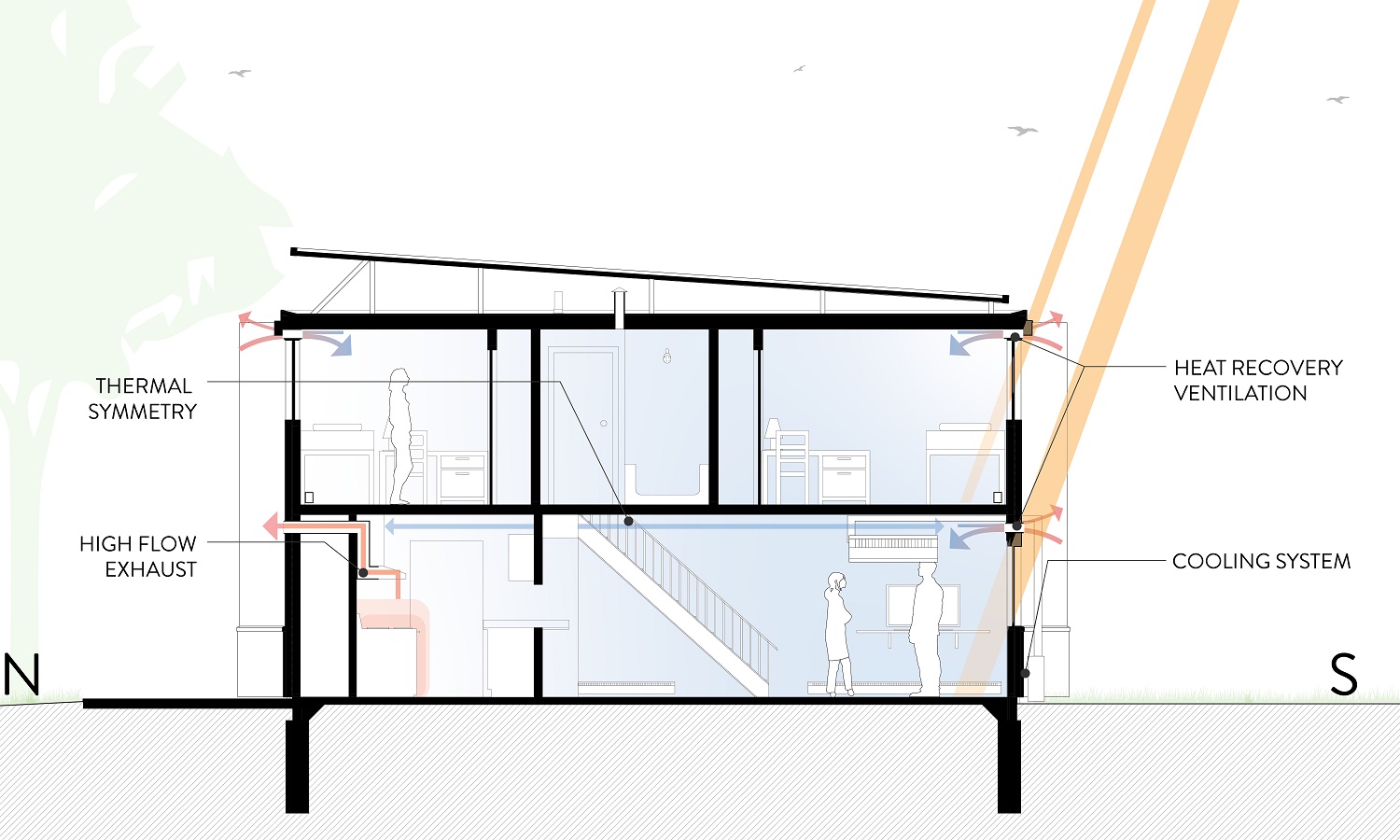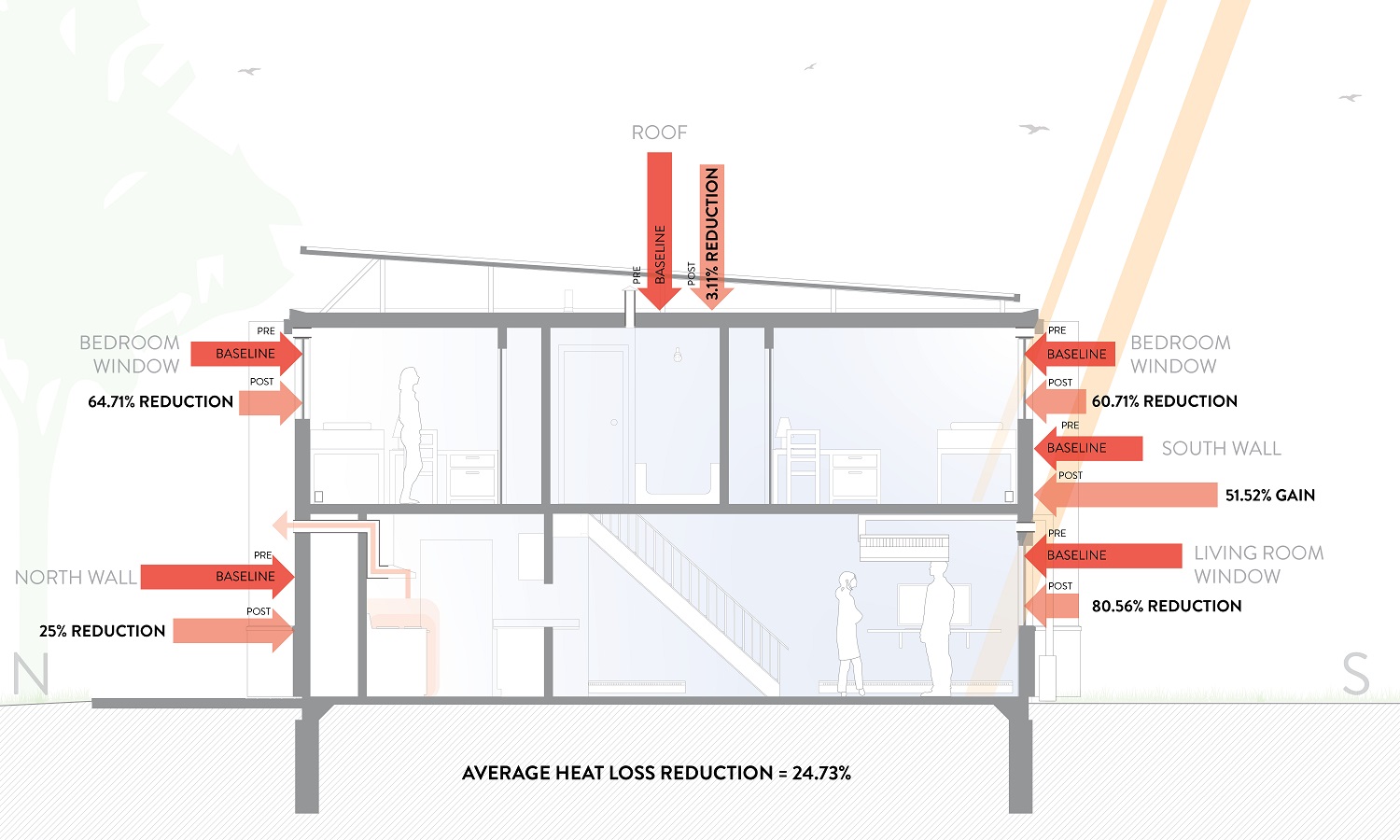




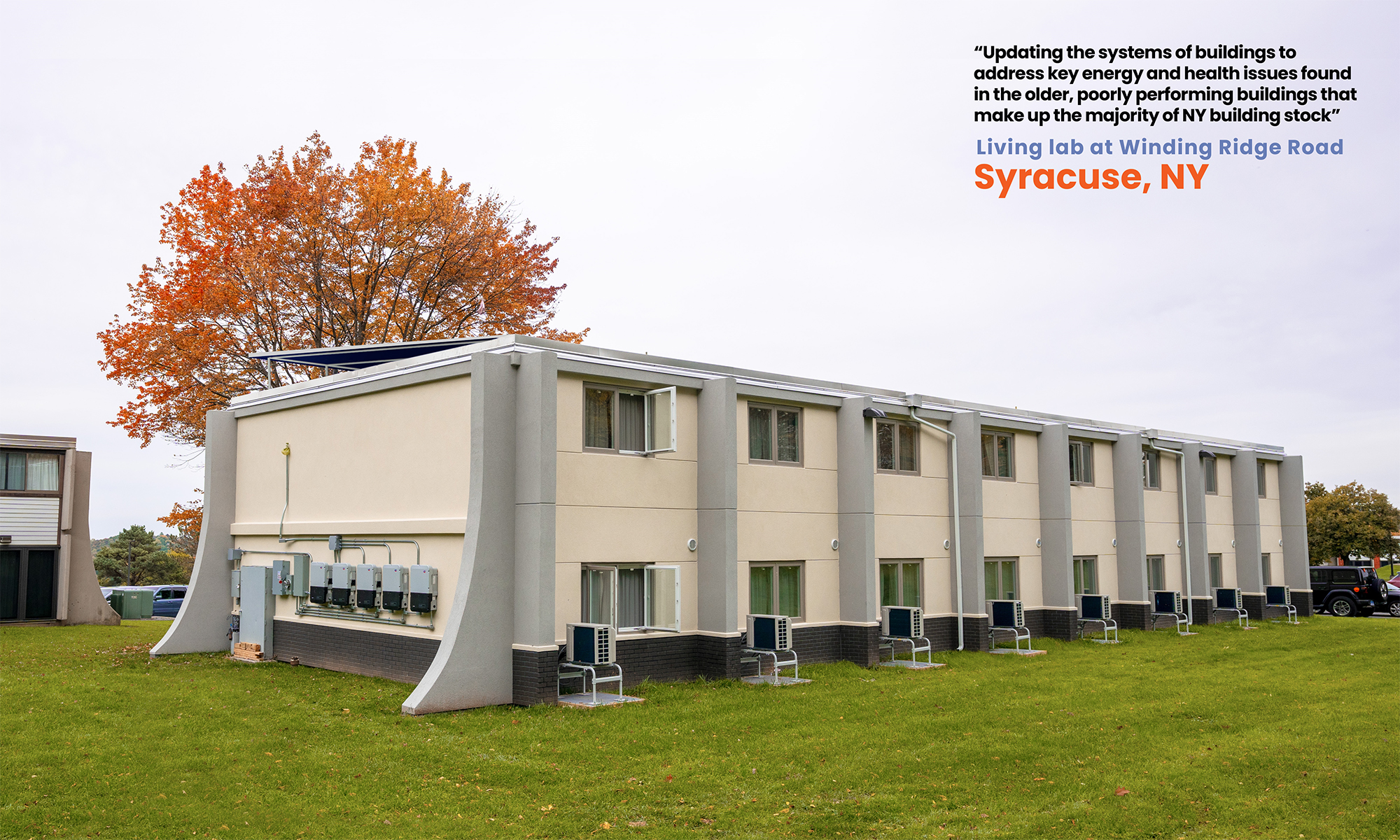
Partners and Contributors
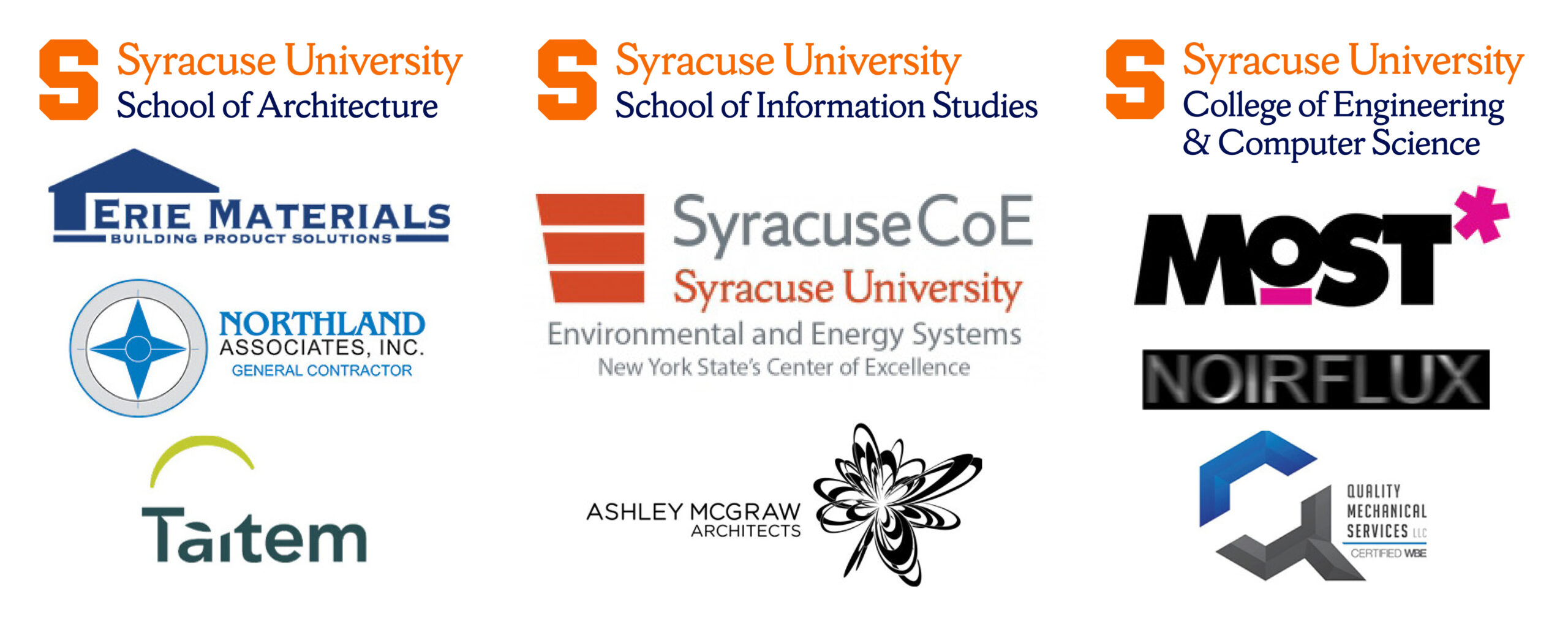
Research Leads
- Nina Wilson, Principal Investigator
- Jeff Hemsley, Co-Pl
- Jason Dedrick, Co-Pl
- Bing Dong, Co-Pl
- Bess Krietemeyer, Co-Pl
- Renee Stevens, Collaborator
- Jonathan Stromer-Galley
Research Assistants
- Caden Bialow
- Julia Chou
- Victorial Chiu
- Jacob Chong
- Beatriz Cypriano
- Audrey Delia
- Wesley Feero
- Shiori Green
- Alexandra Grypinich
- Christopher Hauserman
- Kaylee Holmes
- Zixuan Hu
- Natalie Hugo
- Halie Lestrer
- Zhi Fei Li
- Mason Malsegna
- Pratik Pandey
- Olivia Porrill
- Maria Vazquez Serra
- Yifan Shen
- Ruth Shiferaw
- May Angela Simms
- Angelina Zhang
- Chinmay Anand Yadav
Special Thanks
- John Bryant
- Michael Giannattasio
- Nancy Hard
- Kristen Shapiro
- School of Architecture Staff
- Campus Planning Design and Construction
Overview
Buildings are responsible for 40% of energy use and carbon emissions in the United States, and 600 million tons of construction and demolition waste is generated annually. At the same time, we spend over 90% of our time indoors and the air quality and thermal comfort of our homes and offices has a significant impact on our health and well-being. New York State has launched initiatives aimed at reducing the energy use and carbon emissions of buildings through the implementation of Deep Energy Retrofits (DERs). Inspired in part by the Energiesprong movement developed in the Netherlands, DER approaches in New York update the structures and systems of buildings to address key energy and health issues found in the older, poorly performing buildings that make up the majority of NY building stock. Residents of DER buildings have lower energy costs, breathe better air, and live more comfortably. New York’s Climate Action Plan aims for zero emissions statewide by 2050, and DERs will play a major role in reaching that goal, with millions of residential units slated for retrofit in the coming years.
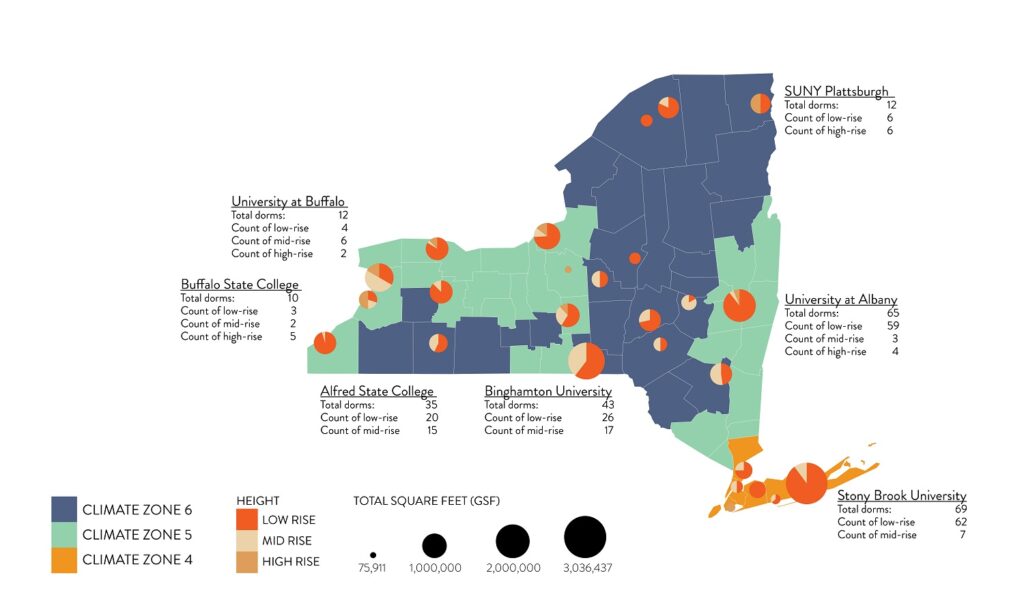
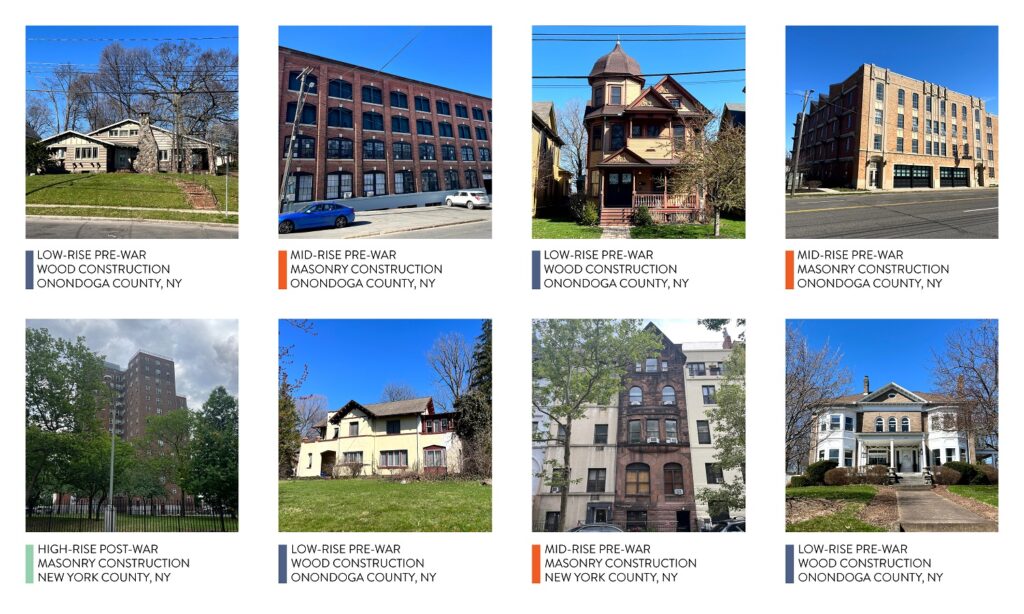
Syracuse University is leading research efforts to develop replicable, economical approaches to Deep Energy Retrofits by aligning laboratory testing of new technologies, computational modeling, and full-scale physical testbeds. The Net Zero Retrofit Living Lab at Syracuse University is a three-year project that identifies, develops, implements, and tests retrofit approaches, including a demonstration project with campus apartment housing. Our team is collecting data on building energy performance, indoor air quality, thermal comfort, and the effects of human actions like opening windows on systems performance, and tying these metrics, or measures, to important outcomes like energy savings and human health and wellbeing.
South Campus
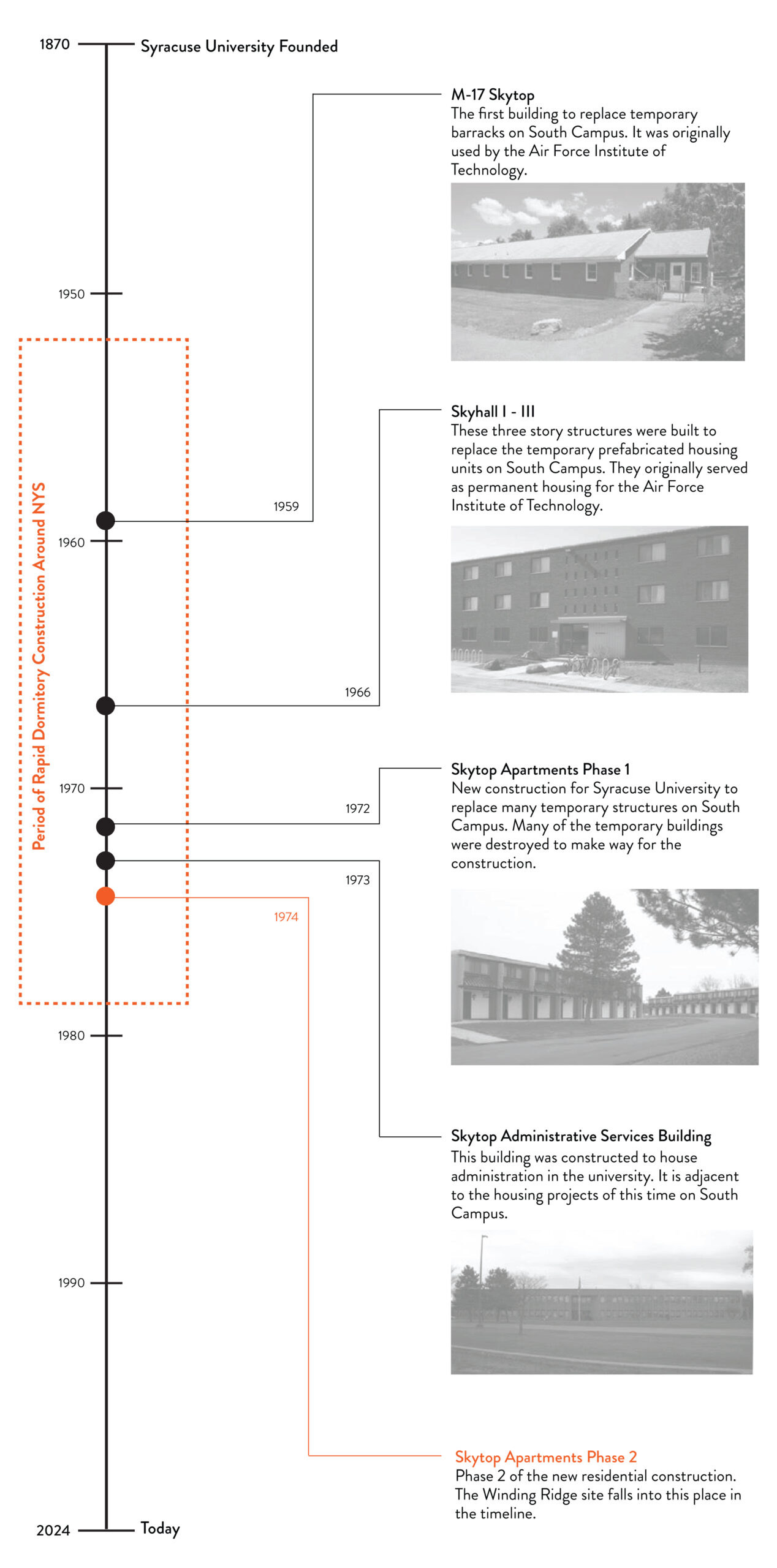
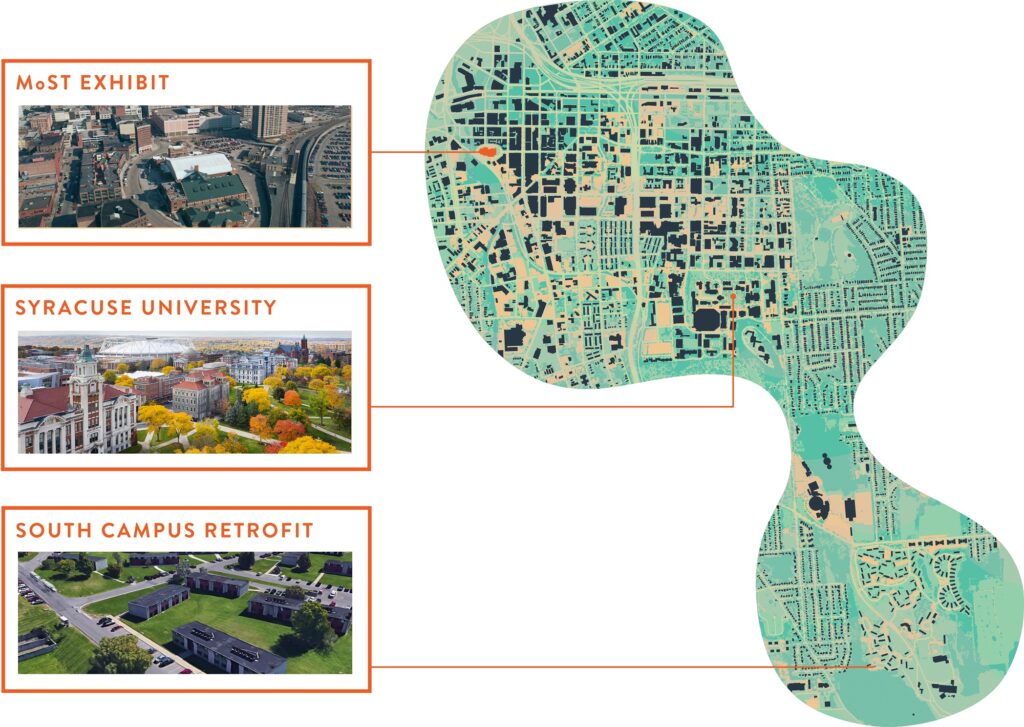
South Campus is located south of the Main Syracuse Campus near the Manley Field House and additional SU Sports facilities. This is all set approximately 3 Miles South of Downtown Syracuse.

Existing Conditions
When are we Comfortable in Syracuse, NY?

During the winter months Syracuse, NY has very few days which are in the “comfortable” zone for most individuals. A typical winter day is below 40 degrees Fahrenheit therefore, buildings must be heated to create a comfortable interior environment.
Summers in Syracuse, NY are more comfortable than winters for most individuals. However, the majority of days are still outside of the “comfort” zone. Characterized by warm humid days the typical summer day is typically between 50-70 degrees Fahrenheit and 50-95% humidity. Therefore, buildings must be cooled and dehumidified to create a comfortable interior environment.
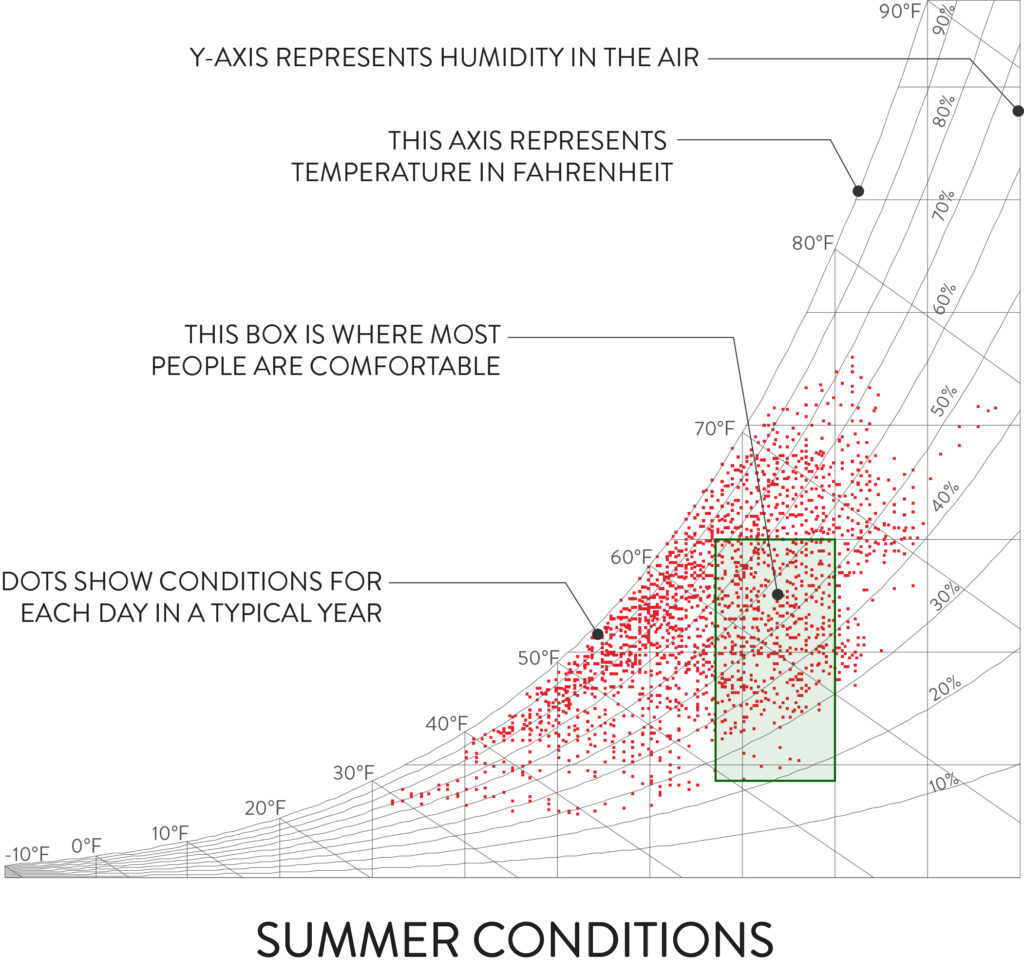
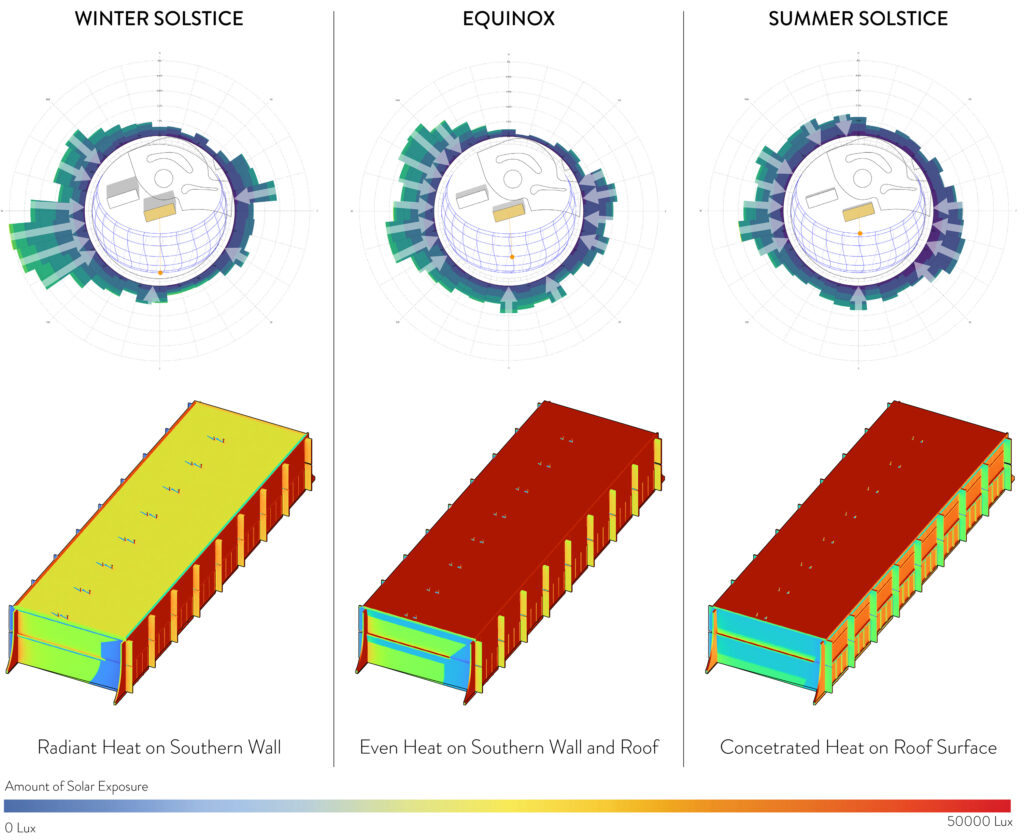
The building is oriented approximately N-S therefore, there is extensive southern exposure all year round. The summer months see a greater exposure on the roof. Taking this exposure into account, it provides an opportunity to generate electivity through solar panels.

- Based off PV Watts Data
Pre-Retrofit Building Breakdown
The existing South Campus apartments are constructed from precast concrete with minimal insulation. Wall Fins extend out from the face of the building creating thermal bridges which radiate heat to the exterior. On the inside the space is heated by baseboard heating which is regulated by the University not the occupants.
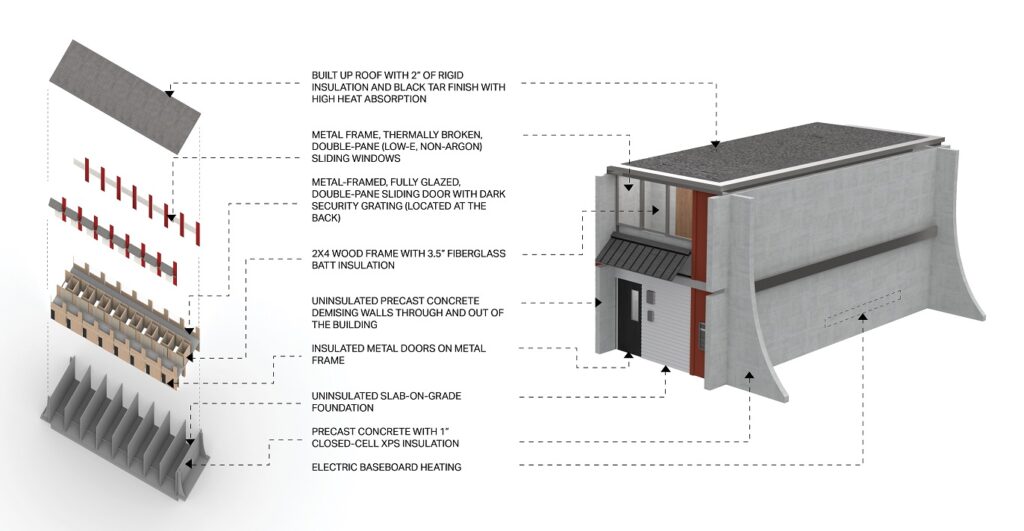
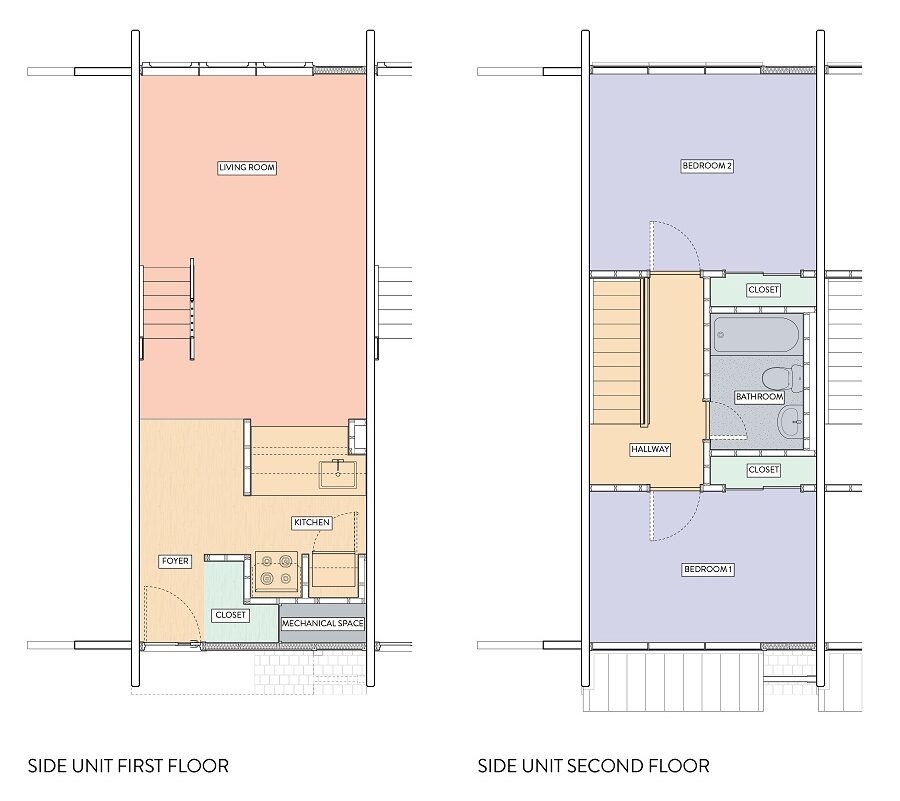
Typical Unit Layout
Radiation Maps Pre-Retrofit

Winter Months
Thermal difference between North and South Bedrooms.
Sun angle is lower during the Winter Months and results in higher greater penetration into space.
Results in Thermal Asymmetry between the North and South Bedrooms.

Summer Months
Thermal difference between North and South Bedrooms.
Sun angle is higher in the sky during the Summer Months concentrating solar exposure in Southern spaces.
Results in Thermal Asymmetry between the North and South Bedrooms.
Pre-Retrofit Conditions
- Winter (Left), and Summer (Right) Conditions of the Pre-Retrofitted Building.
- Slide Fully Right to see full Winter Image | Slide Fully Left to see full Summer Image.
Real Time Conditions
Real time energy consumption of different components in a random retrofitted dorm (in kW)
Air Leakage
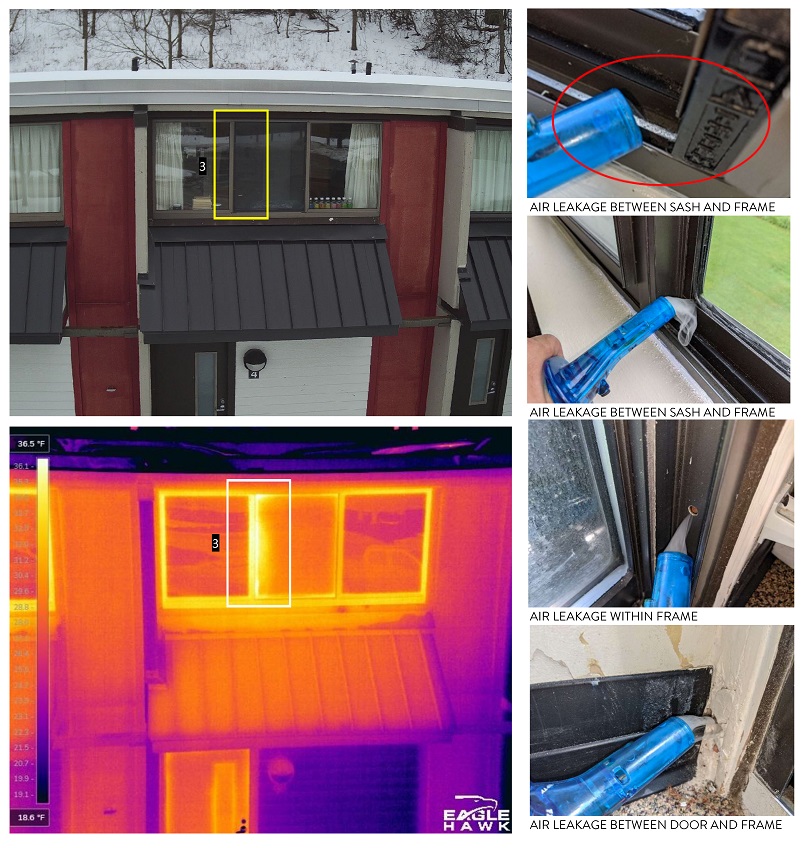
Windows, Window Frames, Doors, and Door Frames leak air.
Results in Thermal Leakage to the exterior.
More Energy is therefore required to sufficiently heat the space.
Temperature and Energy Use
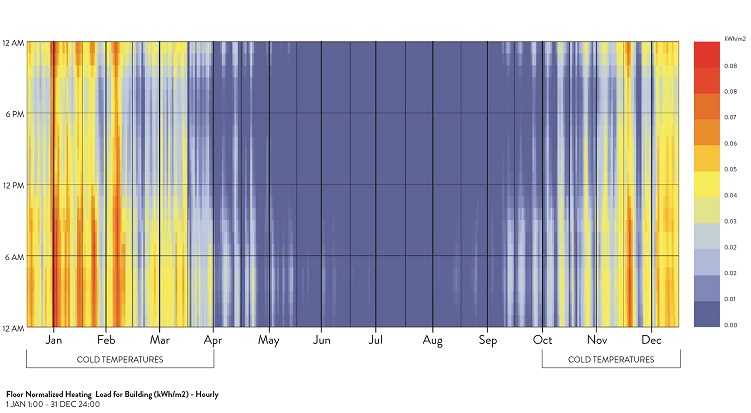

Outdoor Temperatures are the coldest during when buildings are occupied
The Leaky Envelope causes the building to use more energy to keep spaces warm in cold weather
Energy Performance is directly related to Outdoor Temperature
- Winter (Left), and Summer (Right) Heat Loss Conditions of the Pre-Retrofitted Building.
- Slide Fully Right to see full Winter Image | Slide Fully Left to see full Summer Image.
The Approach
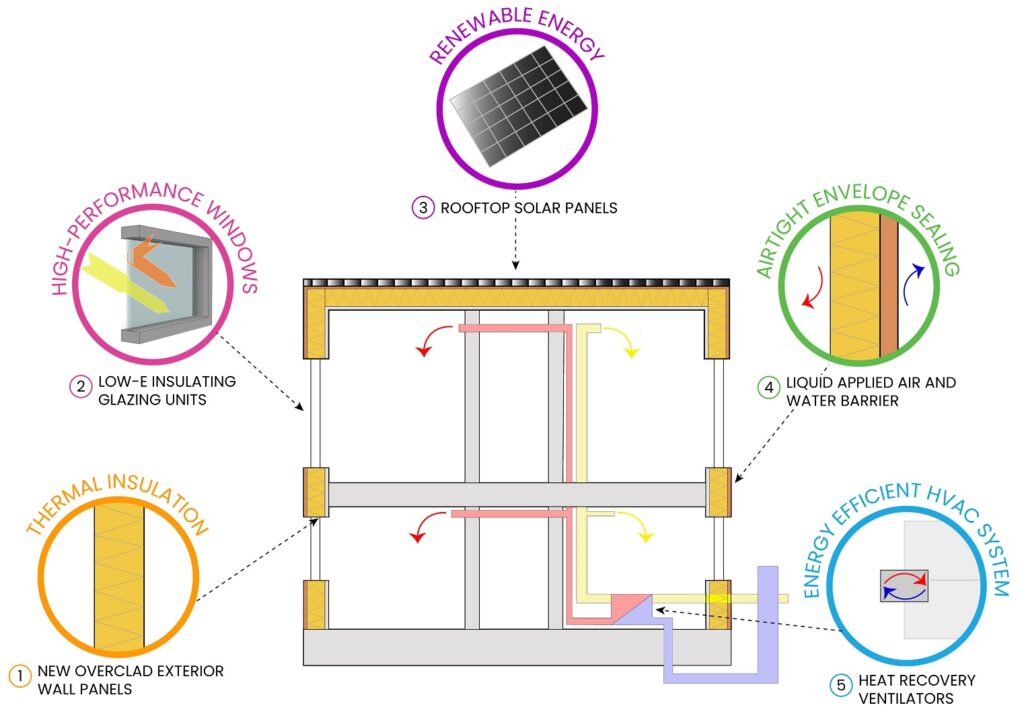
Utilizing the passive house design approach new wall panels were overclad on the exterior in tantum with sealing the envelope. Increasing the insulation of the building. The existing single pane windows re replaced with new High-Performance Windows further increasing the insulating value of the building. These insulating improvements pair with energy efficient Heat Recovery Ventilators which heat and cool the space effectively. Rooftop solar then offsets the energy usage of the building to strive for Net Zero energy use.
Integrated Design Approach
An integrated design approach was undertaken to effectively implement environmental design, operational efficacies, human comfort within the current regulations and codes.
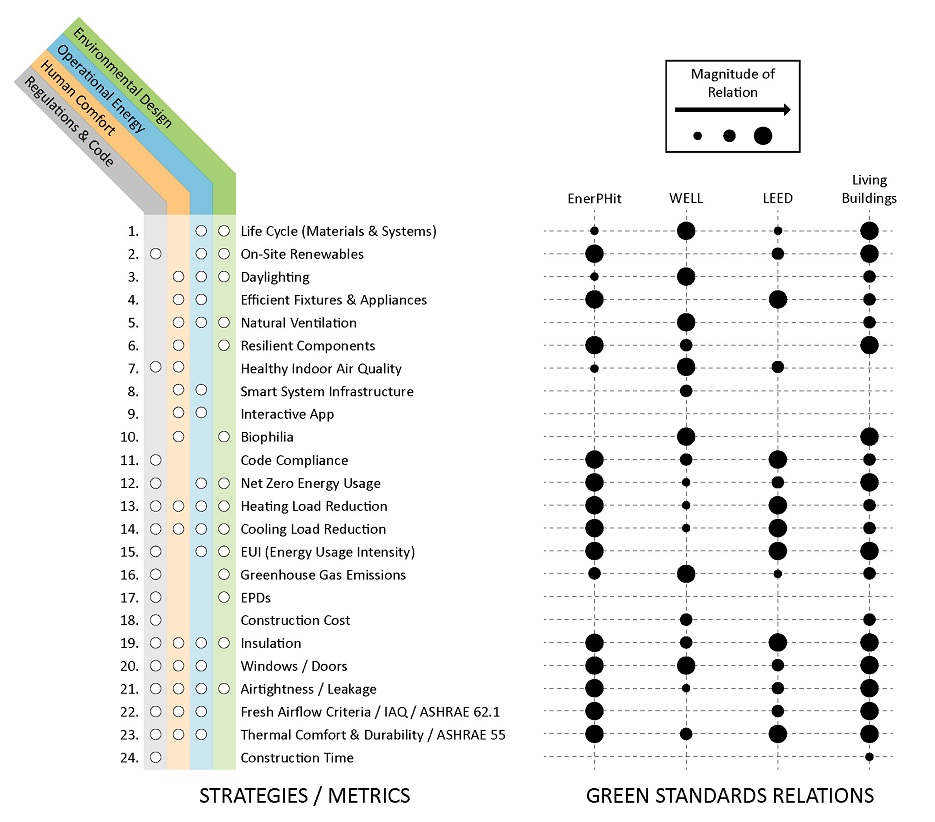
Design Iterations
Mineral Wool

- This iteration proposes exterior areas for residents that become defined through the utilization of frames. These frames both delineate the private spaces of each individual resident’s home, as well as provide potentially exciting instances of climbing vegetation, a space to hang laundry, or even a place to pitch a hammock.
- Vegetation screens in between bedroom windows provide privacy between unit balconies without decreasing sunlight’s access into the interior.
- Small personal vegetation screens for each unit add greenery that students may care and furnish.
- Front entrances are enclosed in vegetation screens to create defined personal outdoor spaces in front of each unit.
Expanded Polystyrene
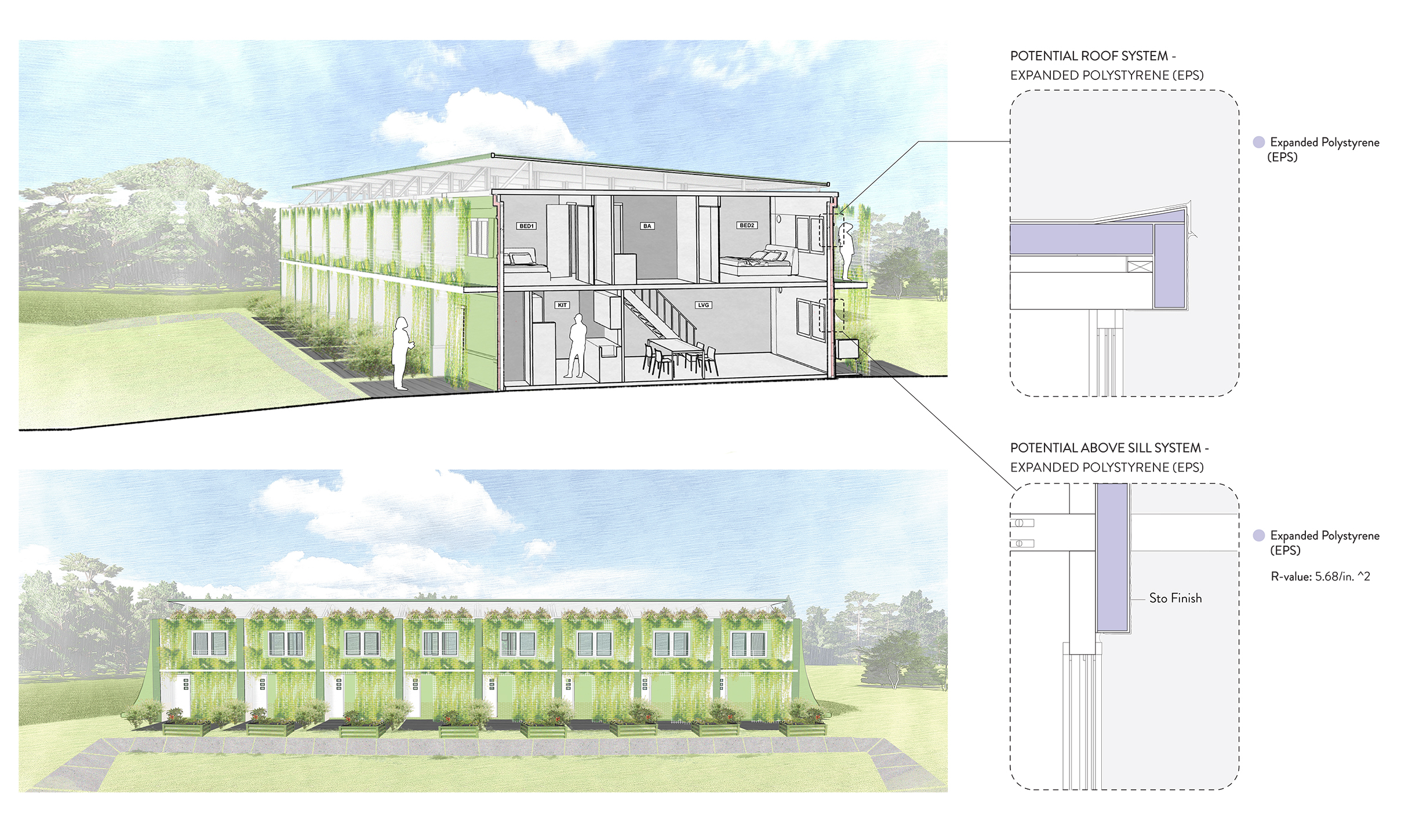
- This iteration proposes a screen that wraps the exterior of the project. This screen could provide for climbing vegetation which provides privacy for residents as well as shading. The presence of vibrant plant life is also beneficial for the well being of students – beauty is a right for everyone.
- Vegetation screens in front of bedrooms windows can be used for extra shading in the summer and for overall privacy throughout the year.
- Small personal vegetation screens for each unit add greenery that students may care for.
- Front entrances are lined with vegetation to create larger individual outdoor spaces in front of each unit.
Polyisocyanurate Foam
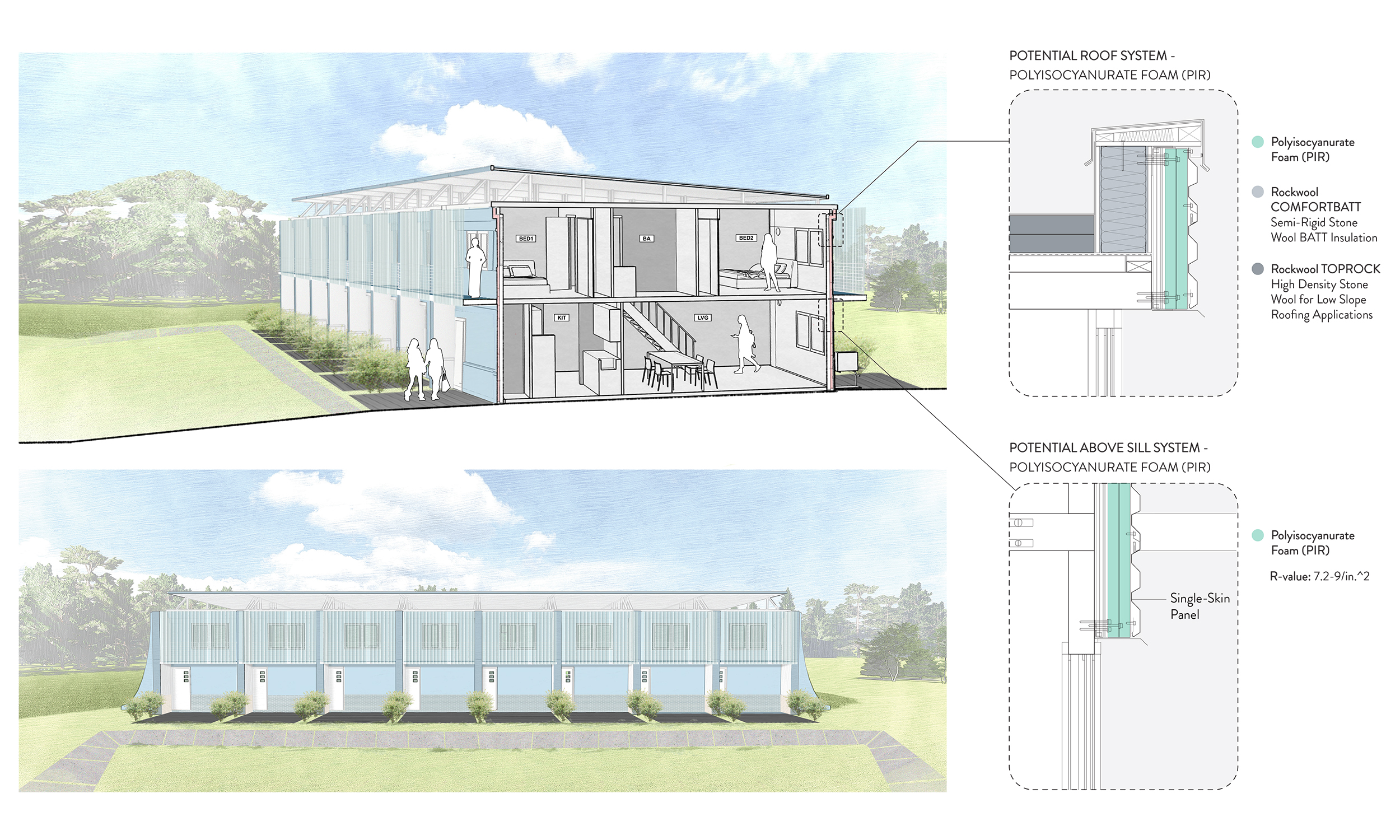
- This iteration proposes a screen that wraps the upper-level exterior of the project. This screen is of a translucent material so as to still provide visibility and sunlight, but to simultaneously give the spacing behind the screen (the bedrooms) more of a sense of privacy, and admittance of diffused light.
- Screens in front of the bedroom windows can be used for extra shading in the summer and for overall privacy throughout the year.
- Front entrances are lined with vegetation to create larger individual outdoor spaces in front of each unit.
Elevation Studies
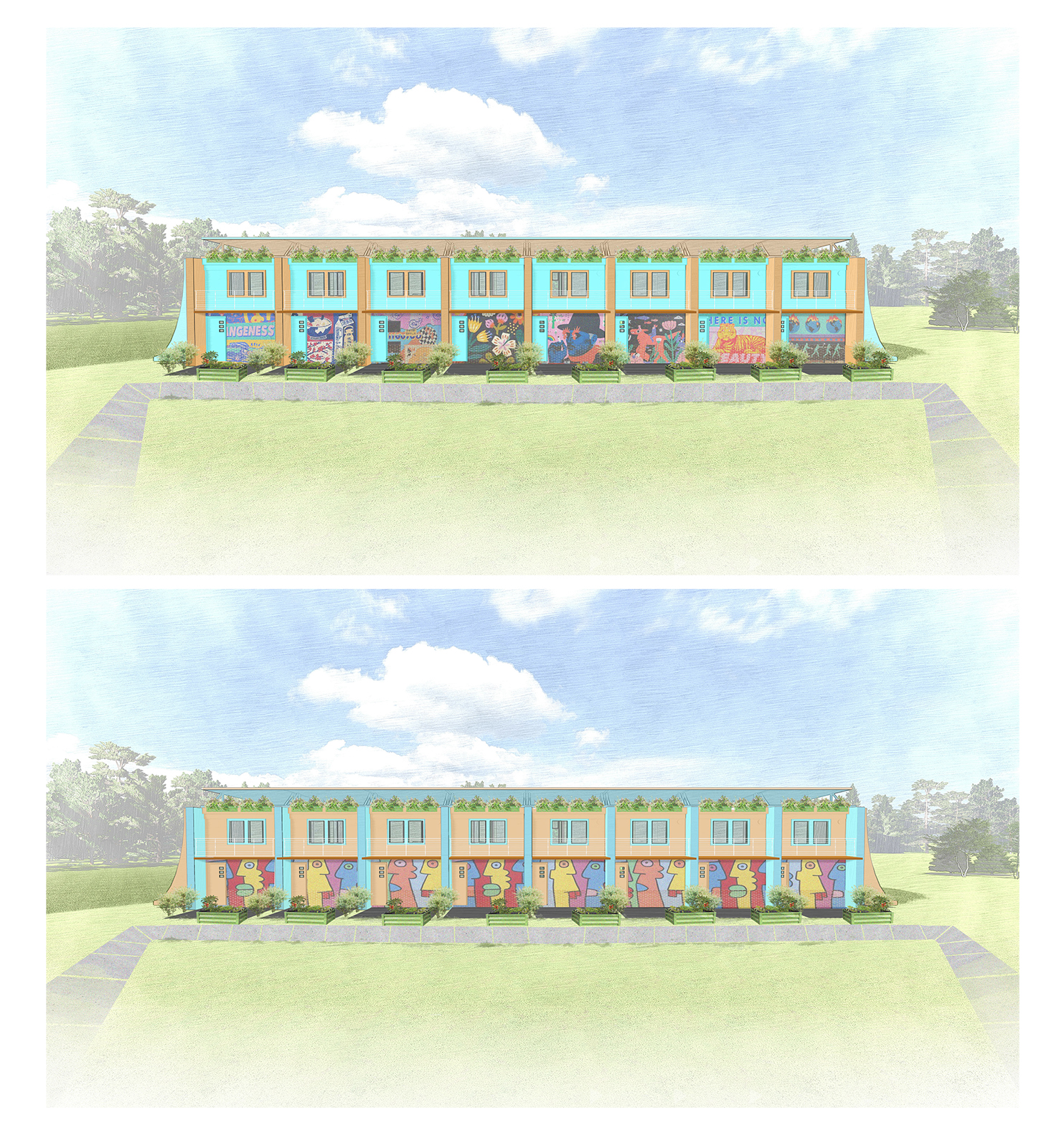
- These two iterations propose the use of vibrant colors that could be used to express both school spirit, and an element of uniqueness for each unit. This could be extended to showcase a mural along the elevation of the project. Each unit could have its own mural (as depicted on the top elevation), or mural could be a long continuous one (as depicted on the bottom elevation). In the former case, perhaps the residents could use this portion of the facade as their own personal mural, contributing and designing it as they wish.
Live Sensor Data
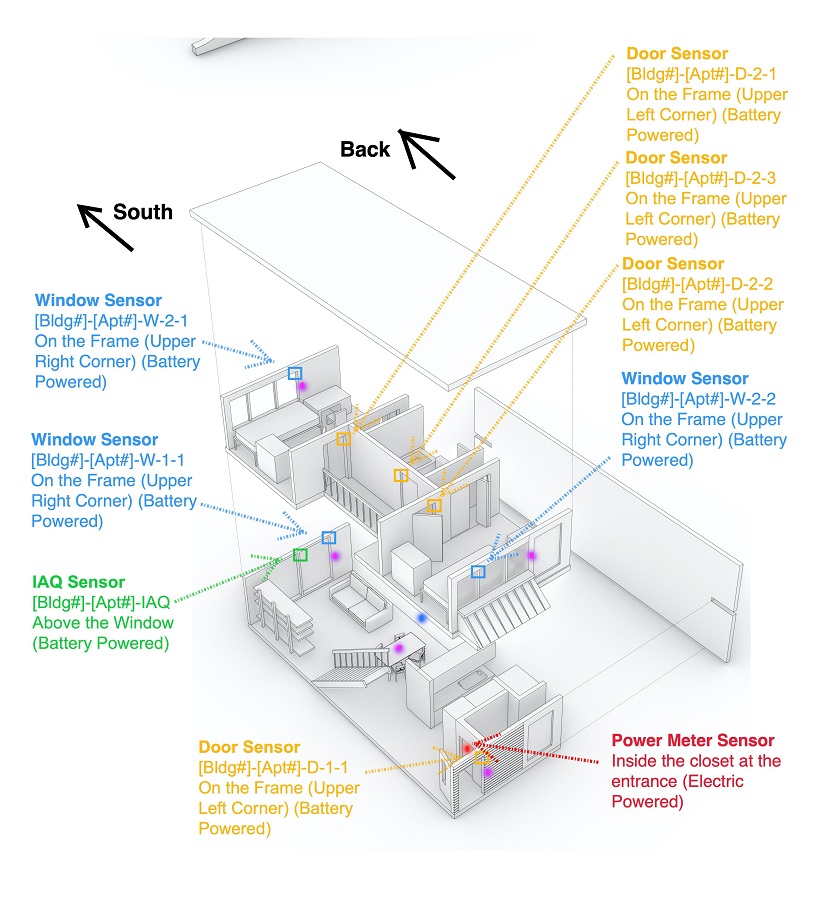
- Indoor Air Quality
- VOCs, CO2, and PM
- Temperature
- Humidity
- Energy Use
- Energy Production
- Occupant Behavior
Post-Retrofit Building Breakdown
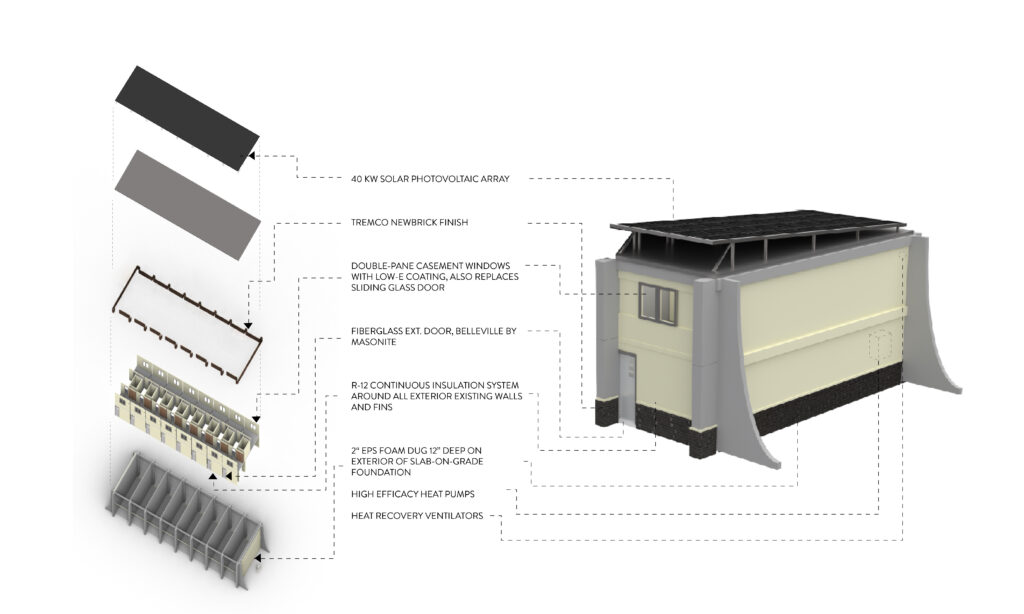
The retrofitted building features new double pane windows, a overclad of R-12 continuous (no breaks for leakage) insulation which covers all exterior surfaces. Extra insulation gets added to the foundation slab-on-grade to further increase the insulating value of the building. The baseboard heating elements are turned off in favor for new high efficiency heat pumps equipped with heat recovery ventilators which can be controlled by the occupants. These new systems are paired with a 40 KW Solar Photovoltaic Array to strive for New Zero Energy use.
Post Retrofit Outcomes
- Winter (Left), and Summer (Right) Post-Retrofit.
- Slide Fully Right to see full Winter Image | Slide Fully Left to see full Summer Image.
Radiation Map Post Retrofit
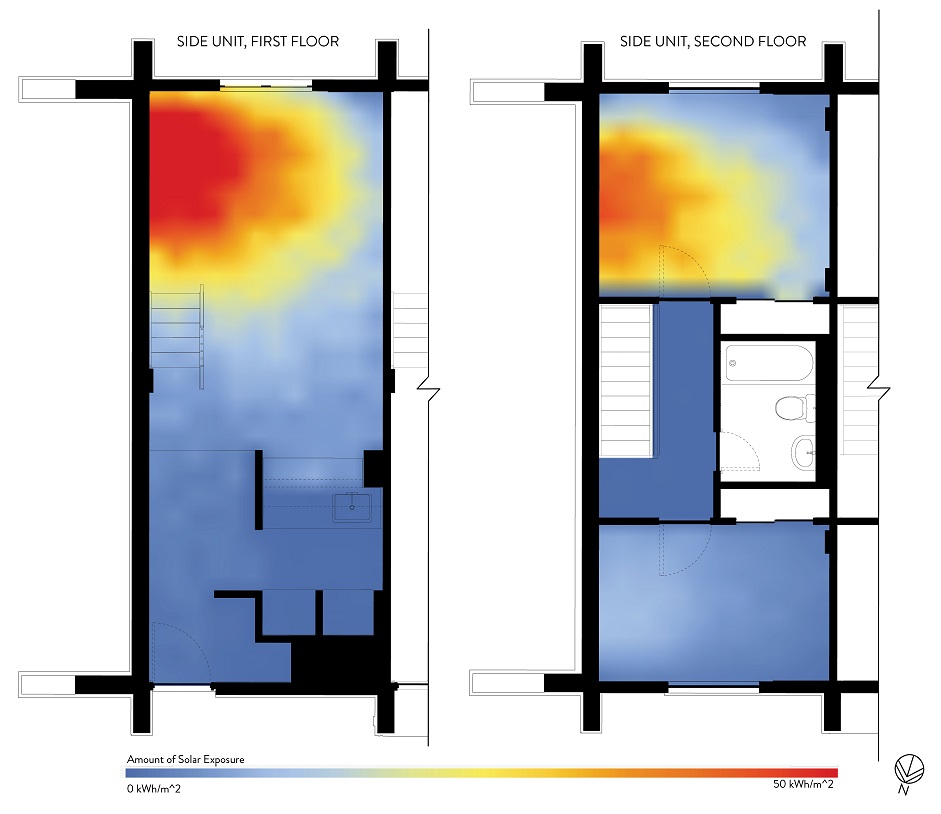
Winter Months
Greater Solar Exposure with a smaller window to wall ratio
Result of removing security screen doors which blocked light into the space

Summer Months
Greater Solar Exposure with a smaller window to wall ratio
Result of removing security screen doors which blocked light into the space
Pre vs Post Retrofit
- Winter Conditions Pre-Retrofit (Left), and Post-Retrofit (Right).
- Slide Fully Right to see full Pre-Retrofit Image | Slide Fully Left to see full Post-Retrofit Image.
- Summer Conditions Pre-Retrofit (Left) and Post-Retrofit (Right).
- Slide Fully Right to see full Pre-Retrofit Image | Slide Fully Left to see full Post-Retrofit Image.
- Winter Estimated Heat Loss Pre-Retrofit (Left) and Post-Retrofit (Right).
- Slide Fully Right to see full Pre-Retrofit Image | Slide Fully Left to see full Post-Retrofit Image.
- Summer Estimated Heat Loss Pre-Retrofit (Left) and Post-Retrofit (Right).
- Slide Fully Right to see full Pre-Retrofit Image | Slide Fully Left to see full Post-Retrofit Image.
Post Retrofit Outcomes

Runaway baseboard heating overheated the space during the winter which made residents open the windows to improve comfort. A reduction in window use was a direct result of improving the heating systems within the building, causing a reduction of energy use.
Indoor Air Quality

By improving the environmental systems through HRVs (Heat Recovery Ventilators) the buildings indoor air quality was improved to acceptable indoor VOC (Volatile Organic Compounds). This reduction was from an average annual hourly level of approximately 1000ppb to levels lower than 500ppb.
Average Indoor C02 Levels
*Citation for safe standard value: ASHRAE Position Document on Indoor Carbon Dioxide
Average Indoor Volatile Levels
*Citation for safe standard value: Fitwel Enhanced Indoor Air Quality Testing and Monitoring Protocol
